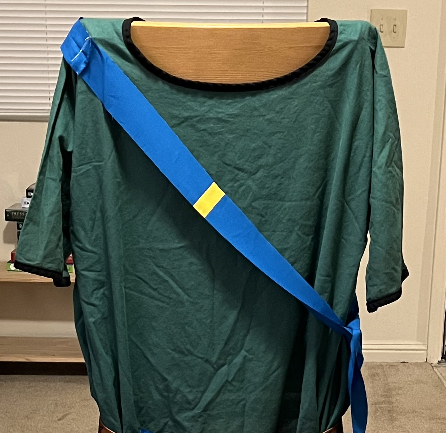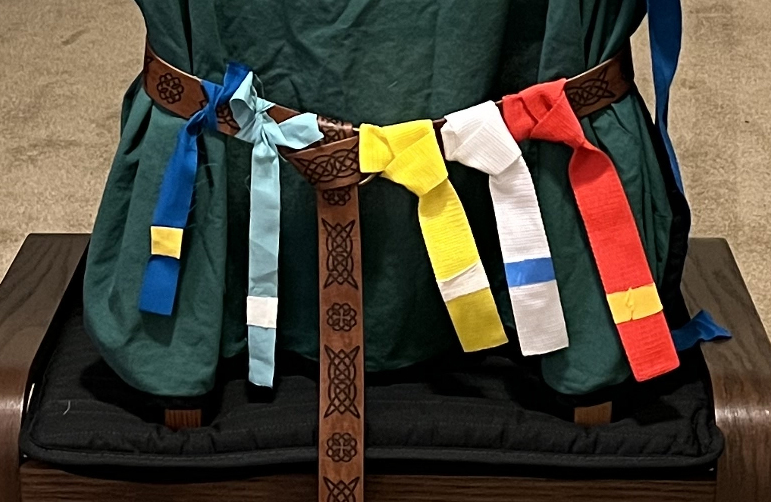Difference between revisions of "V9: Visual Indicators"
From AmtWiki
m |
|||
| Line 5: | Line 5: | ||
<div class="mw-collapsible-content"> | <div class="mw-collapsible-content"> | ||
Visual Indicators are a functional piece of [[V9: Garb|garb]] that serves to provide at-a-glance information to other players on the field. While Amtgard uses a number of standardized Visual Indicators, [[V9: Custom Rules and Accommodations|custom]] indicators can also be created for specific events, such as Team Headbands. | Visual Indicators are a functional piece of [[V9: Garb|garb]] that serves to provide at-a-glance information to other players on the field. While Amtgard uses a number of standardized Visual Indicators, [[V9: Custom Rules and Accommodations|custom]] indicators can also be created for specific events, such as Team Headbands. | ||
| − | |||
| − | |||
{{:V9: Indicator Strips}} | {{:V9: Indicator Strips}} | ||
Revision as of 01:22, 19 November 2023
This page is part of the Official Amtgard V9 Alpha-Playtest Rulebook.
- The Amtwiki is the official home and primary source for Amtgard V9 Rules as of February 25, 2023.
- These rules are currently in Open Alpha Playtest. See the Playtest Disclaimer for more details.
- To learn more about Amtgard V9 Development, please visit Amtgard.com.
- To view the current Amtgard V8 ruleset, please see the Amtgard V8 Rulebook.
Visual Indicators
Visual Indicators are a functional piece of garb that serves to provide at-a-glance information to other players on the field. While Amtgard uses a number of standardized Visual Indicators, custom indicators can also be created for specific events, such as Team Headbands.
Indicator Strips
Indicator Strips are primarily used to denote Enchantments and strike enhancements to other players.
- Indicator strips cannot be worn unless an ability or effect requires it.
- Players that are required to wear indicator strips must do their best to wear them in a location that is clearly visible to other players, notably enemies, and unlikely to become obscured by garb or other equipment (such as shields) during the course of gameplay.
- Indicator strips cannot be deliberately hidden or otherwise obscured from players who might be trying to see them.
- Indicator strips must be removed as soon as possible after their associated effect is removed.
- Players carrying unused indicator strips (such as a druid with many enchantments) should do their best to make sure that those strips are well-hidden from view so they are not mistaken for active enchantments during gameplay. Repeated or egregious disregard for this rule can result in removal from play by a Reeve or Rules Authority until the issue is resolved.
Construction Rules
- Must be at least 1" wide, with at least 6" of visible drape when worn.
- Every indicator strip is associated with an ability or effect and must match the appropriate Color Code.
- Color blind aids should run across the strip short-ways (see image). We recommend placing lines on either end of the strip. Use double-lines for better visibility or if the strip has other designs that might pull focus.
Sashes

A simple Bard sash
Sashes are primarily used to denote a player's Class. They must be worn from the shoulder to the opposite hip across the body in a manner that not obscured by garb or other equipment.
Construction Rules
- Must be at least 2" wide.
- Every sash is associated with an class or custom rule and must match the appropriate Color Code.
- Color blind aids should run across the sash short-ways (see image). We recommend placing the lines on either side of the player, roughly at heart-level; however you can adjust the placement to suit your kit and avoid obstruction by shield or garb. Use double-lines for better visibility or if the sash has other designs that might pull focus.
Visual Indicators Sashes
Equipment Equipment Basics · Equipment Use Terms · Weapons · Shields · Armor · Color Code · Visual Indicators


